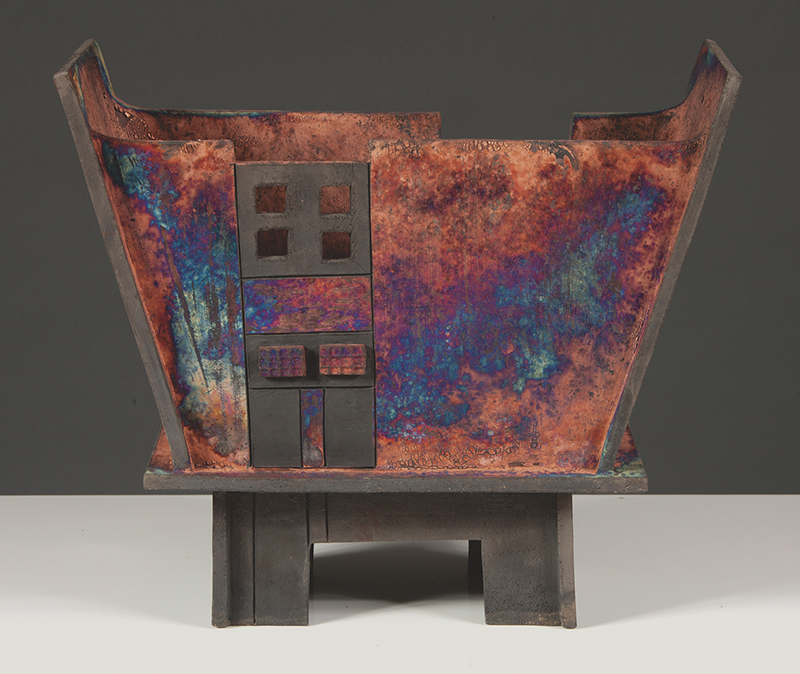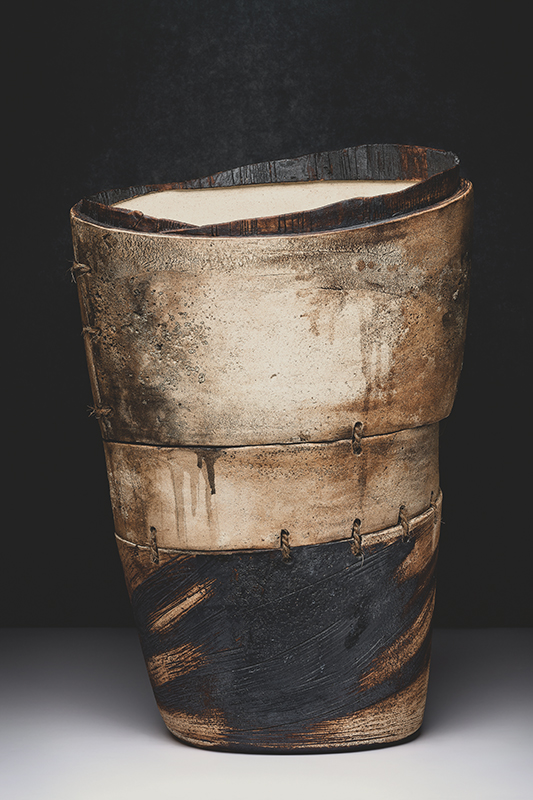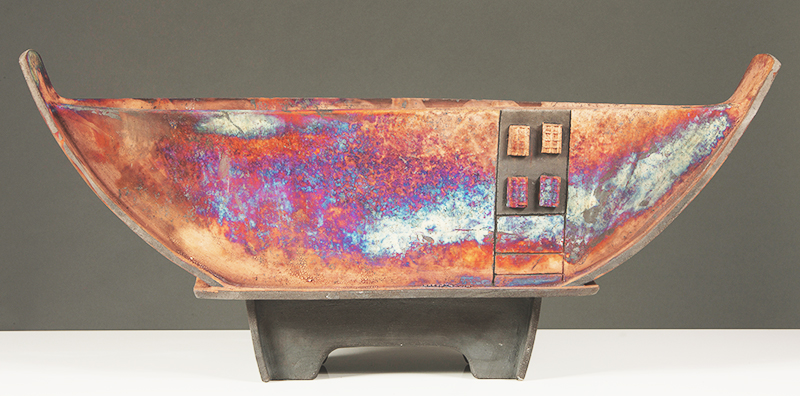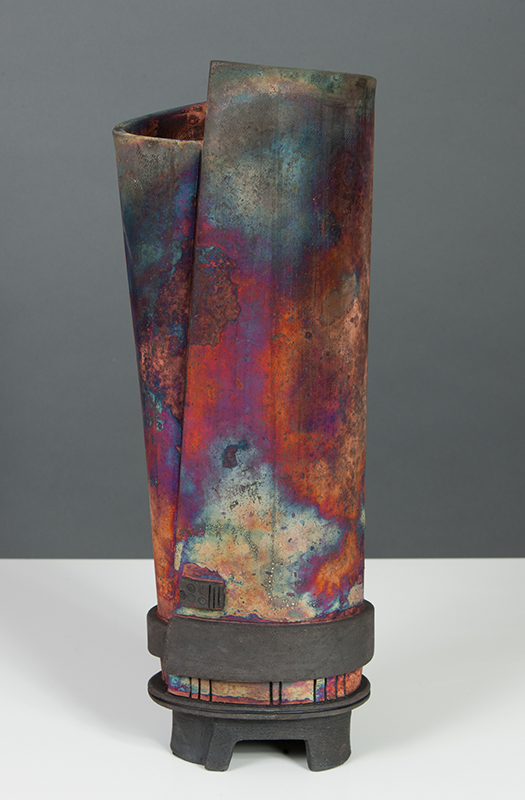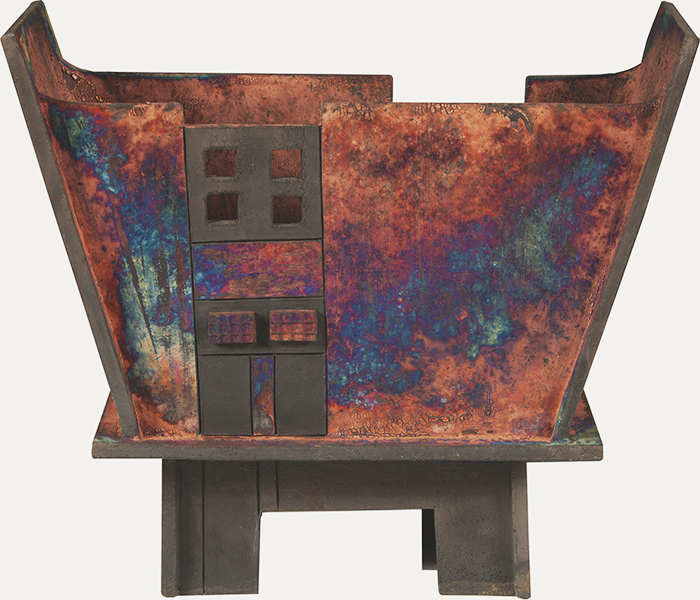Christine Audet
Par/by Guy Ouellet

-
Quand la céramique rencontre l'architecture et l'archéologie
C’est l’histoire d’une blondinette de huit ans en visite à la campagne chez ses grands-parents et qui découvre de l’argile sur les rives du lac.
Étonnée, curieuse, la fillette ne tarde pas à constater qu’elle peut donner de multiples formes à cette étrange pâte à modeler.
Ce fut le déclic originel pour la petite Christine Audet. Soudainement animée par une passion qui n’allait jamais cesser de croitre, une céramiste venait de naître! Cette passion l’amènera jusqu’à l’université, puis de par le vaste monde pour parfaire ses connaissances et explorer à fond l’art de la céramique. Chemin faisant, elle se découvre un vif intérêt pour l’architecture et l’archéologie, deux domaines qui ne tarderont pas à s’imprimer dans ses œuvres. En effet, on dit souvent que celles-ci donnent l'impression d'objets sortis de fouilles archéologiques.
C’est au cours d’un voyage au Japon que Christine Audet s’initie à une méthode de cuisson bien particulière qu’on appelle le raku. Il s’agit de la seule méthode de cuisson dont les pièces sont défournées à chaud. Cette technique permet d’obtenir de riches coloris et une terre de couleur très foncée que l’artiste utilise en contraste comme élément décoratif.
Bien que Christine Audet soit aujourd’hui considérée comme une véritable spécialiste du raku, l’artiste ne contrôle pas tout pour autant. En effet, la chaleur du four et le choc thermique résultant de la sortie du four à 1900 degrés F jusqu’à la température ambiante peut altérer les couleurs et même détruire l’œuvre. Se mettre en danger en jouant avec les reliefs et les contrastes constitue donc un défi quotidien pour la céramiste qui accepte de connaitre 30 % d’échec à chaque cuisson de ses œuvres.
À ce sujet, Christine Audet se montre philosophe : « Si je pouvais tout contrôler ce serait trop facile! La technique me challenge et j’aime challenger la technique », lance-t-elle en riant.
Parallèlement au raku, elle travaille des grès à haute température au gaz en atmosphère réductrice. Cette approche lui a permis d'acquérir de nouvelles connaissances techniques et de développer des formes et des coloris très différents du raku.
En quarante ans de carrière, Christine Audet a participé à plus d'une centaine d'expositions au Québec, en Ontario, aux États-Unis et en France.
Si le passage des ans a fait grisonner la tignasse couleur maïs de la petite fille, l’étincelle dans son regard est toujours aussi scintillante qu’à huit ans!
-
When ceramics meet architecture and archeology
It’s the story of an eight-year-old fair-haired girl visiting her grandparents at the countryside and discovering clay on the shores of the lake. Surprised and curious, the little girl soon realizes that she can give multiple forms to this strange substance.
This was the spark for little Christine Audet. Suddenly driven by a passion that would never stop growing, a ceramicist was born! This passion would take her all the way to university, then to the wide world to hone her knowledge and explore the art of ceramics in depth. Along the way, she discovered a keen interest in architecture and archeology, two areas that would soon be reflected in her work. Indeed, it is often said that these give the impression of objects coming out of archaeological excavations.
It was during a trip to Japan that Christine Audet discovered a very special curing method called raku. This is the only method in which the pieces are removed from the oven hot. This technique produces rich colors and a very dark earth color that the artist uses in contrast as a decorative element.
Although Christine Audet is now considered a true raku specialist, the artist is not in total control. In fact, the heat of the oven and the thermal shock resulting from leaving the oven at 1900 degrees F to room temperature can alter colors and even destroy the work. Putting herself in danger by playing with reliefs and contrasts is therefore a daily challenge for the ceramist who accepts to experience 30% failure with each firing of her works.
On this subject, Christine Audet shows herself to be philosophical: « If I could control everything, it would be too easy! The technique challenges me and I like to challenge the technique, » she laughs.
Along with raku, she works high temperature stoneware with gas in a reducing atmosphere. This approach has allowed her to acquire new technical knowledge and to develop very different shapes and colors from raku.
In her forty-year career, Christine Audet has taken part in more than a hundred exhibitions in Quebec, Ontario, the United States and France.
If the passage of time has made the little girl's corn-colored ponytail gray, the twinkle in her eyes is still as vibrant as it was when she was eight years old!

